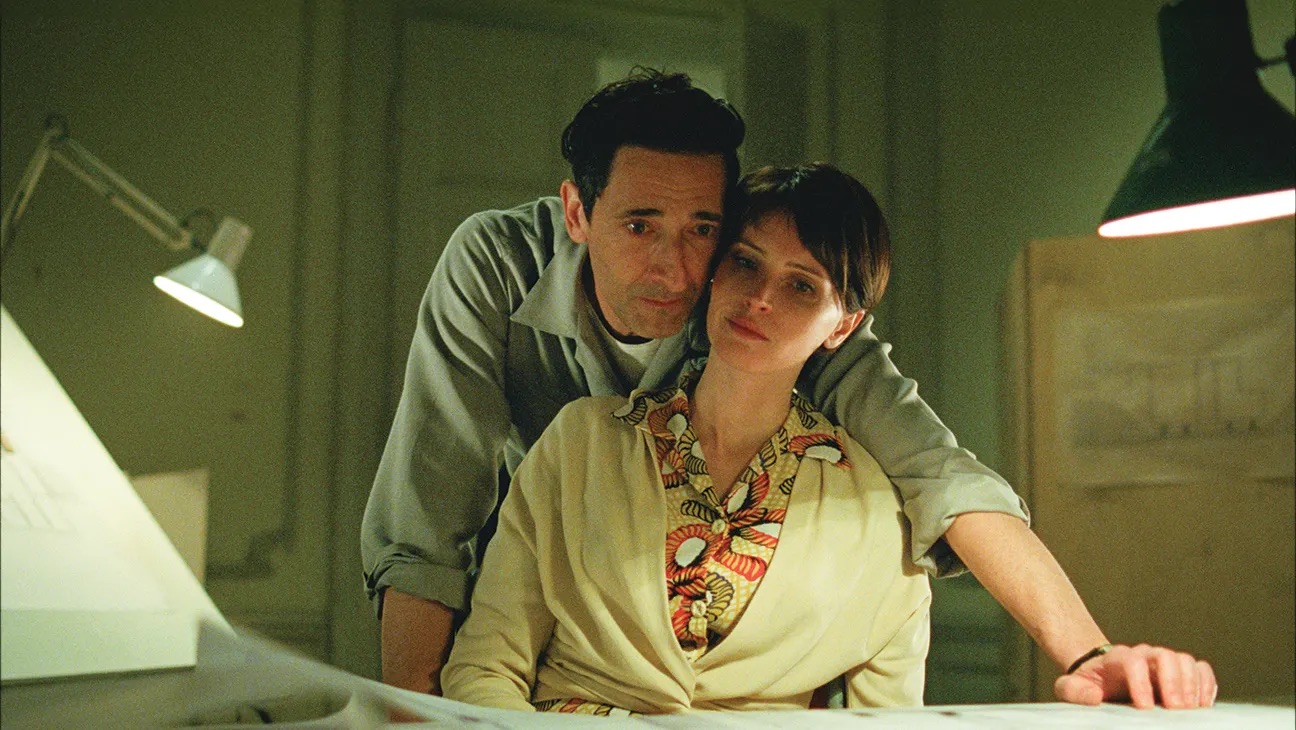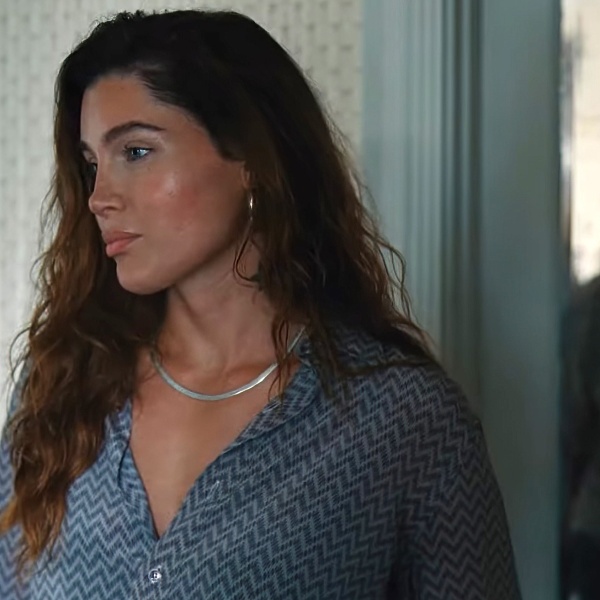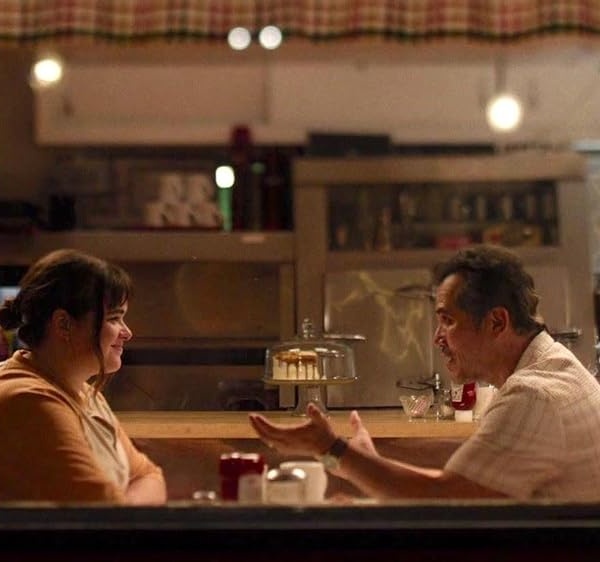It might seem too easy to observe that Brady Corbet’s “The Brutalist” — a 215-minute slab of a film that spans 30 years in the life of Hungarian-Jewish architect and Holocaust survivor László Tóth (Adrien Brody), who flees to America in the hopes of building a better future — has been constructed to embody the aesthetics of its title character. Shot in VistaVision and projected on 300lbs.’ worth of 70mm film stock, Corbet’s epic draws a perfectly self-evident connection between the weight of its raw material and that of the concrete monolith Tóth creates over the course of the story, and the same could be said of its minimalistic framing, its bone-deep aversion to nostalgia, and, most of all, the movie’s efforts to reveal the soul of its subject through the geometry of its design.
But anyone familiar with Corbet’s previous features (“The Childhood of a Leader” and “Vox Lux”) will recognize that the seismic and shuddering obviousness of his style provides its own point. A deadly serious and fetishistically Euro-centric young auteur who’s fascinated by the cyclical relationship between trauma and culture (“The Childhood of a Leader” was about the abuse suffered by a fascist tyrant during his formative years, “Vox Lux” about how a school shooting gave rise to a pop star whose celebrity is then repurposed towards even more fatal ends), Corbet delights in the violent cause-and-effect of the 20th century, which shook the Earth off its axis in a way that invited people to reimagine it in their own image.
Private lives were transmuted into public exteriors until it became impossible to ignore how we shape the world by moving through it, with personal experience revealed to be as inextricable from collective history as artists are from their work, as concrete is from a building, or — to put an even finer point on Corbet’s latest greatest (and least hostile) accomplishment to date — as immigrants are from America. László Tóth is “The Brutalist,” and “The Brutalist” is László Tóth. And so it stands to reason that both of them are similarly brilliant and immense, just as both of them struggle to realize the full genius of their vision.
The film begins with a frenzied prologue that cuts across both sides of the Atlantic, fusing together the old country and the new — past and present — in a way that instantly denies Corbet’s hero any hope of leaving his trauma behind. Adding insult to injury, the sequence is capped off with Tóth’s arrival at Ellis Island, which sees the lanky émigré scrambling through the darkened bowels of a ship in order to get his first glimpse of America… only for Lol Crawley’s swirling camera to find the Statue of Liberty upside down. Ominous! Even more troubling: Tóth can’t get an erection with the sex worker he visits on his first night in town. Maybe he just misses his wife back in Budapest (Felicity Jones as Erzsébet), or maybe some ineffable trace of his pain has been a passenger to him on his journey.
No matter, Brody has always embodied a certain tenaciousness (in both his screen image and his career trajectory), and he won’t let Tóth get disheartened so easily. We’re told that his character’s nose is broken, but the actor’s face makes it impossible to tell. This is a man on the upswing, and he’s carried to Philadelphia on the strength of Daniel Blumberg’s throbbing score, which pivots between industrial percussion and brassy jazz horns with the force of a twin-piston engine. Corbet lets it rip all too selectively, but the music provides a perfect accompaniment to the epistolary montages in which Tóth’s letters to Erzsébet are intercut with archival footage of post-war industry, as if it were the sound of personal biography getting ingested into history.

When Tóth arrives in the City of Brotherly Love, he’s welcomed by his cousin with open-ish arms (the shifty cousin is played by a brilliant Alessandro Nivola, whose beaming face betrays a war of attrition between loyalty and assimilation). The cousin has married a shiksa, changed his last name to Miller, and opened a furniture store on the strength of a white Jew’s ability to pass as a gentile, and he’d love for Tóth to follow in his footsteps. But Tóth’s accent is too thick, his heart too heavy, and his generosity too pronounced to mix into a society defined by capitalistic self-interest; the kindness he shows to a Black worker (the great Isaach de Bankolé) on the breadlines is a dead giveaway, and his enduring allegiance to that new friend will threaten to end his American Dream before it even starts.
But Tóth is talented, and America will always have use for talent. He designs a chair very similar to Marcel Breuer’s Cesca (Breuer’s life being the closest real-world analogue to the fiction of Tóth’s experience), which inspires the shit-eating son of a prominent local industrialist — Joe Alwyn, who loves to play the most loathsome men alive — to hire him to redesign his father’s library. And so our hero crosses paths with his future patron and personal tormentor Harrison Lee Van Buren, who would be a monstrous caricature of capitalism’s worst perversities if not for the softness that Guy Pearce so gingerly laces into his sadism.
Warped by the value system of a country where people are taught to deserve whatever they can take, Van Buren figures that he can lay claim to Tóth’s singular talent. He reasons that immigrant labor should be cheap and grateful, and so — in exchange for a pittance of a salary and a place to live — he offers Tóth the commission of a lifetime. Ostensibly a tribute to Van Buren’s late mother (but really a monument to himself), the Institute will be a sprawling library/civic center/church/whatever on a hill that people will be able to see for miles in every direction. It will also look like the concentration camp that Tóth recently survived, but Van Buren sees that as more of a feature than a bug. The illusion of progressiveness is an invaluable disguise for anyone so perniciously at peace with the way things are. Besides, Tóth’s style is less important to Van Buren than his vulnerability; it’s easy for a billionaire (adjusted for inflation) to keep an unsettled immigrant under his thumb, and to erase them from the narrative if they ever threaten to make it about themselves.
Aside from the occasional detour or dead end, the rest of the film’s three-and-a-half-hour running time is devoted to Tóth’s work on the Doylestown project — a project that soon takes on the same life-devouring scale as the play from “Synecdoche, New York.” Tóth is sustained by the momentum of the build, but feels the past nipping at his heels whenever construction sputters to a halt. He doesn’t fare well during such periods of frustration, most of them byproducts of Van Buren’s erratic whims and steadfast ego. Though the film around him — never dull — is largely sustained by the subtleties of the character’s wilting optimism.
Brody is raw, sincere, and commanding in a role that evokes “The Pianist” in too many ways to count, his skinny body and sloping face slowly drooping into a portrait of disillusionment that Corbet will exaggerate in all sorts of awful directions across the back half of this story (which is neatly divided into three parts, along with a cute 15-minute intermission that comes with its own timer). “We are not yet free,” Tóth writes to his wife as he begins to chafe at his golden handcuffs, and Erzsébet’s arrival in the U.S. some 10 years later will only serve to underscore the conditionality of their status there.
The closer the Institute gets to completion, the more tenuous Tóth’s value to Van Buren becomes. Much of the credit for tracking that process belongs to “Carol” production designer Judy Becker, whose sorcery allows the Institute to become a character unto itself, and sells us on the illusion that Corbet’s financiers paid for him to build a massive real estate project in the Hungarian countryside; the visual changes to the building are more dynamic than any of the personal dramas suffered by the rest of the cast, which tend to feel small and undetailed against such an epic backdrop.
Jones bares the worst of it, the actor nobly struggling against the confines of a role that never rises above the frustrated voice of reason that it’s meant to represent. She begs her stubborn husband to back away from the project and embrace one of the endless possibilities it’s made available to him. She gives him another of modern cinema’s invariably anguished handjobs, and begs him to do what’s best for their vulnerable niece (Raffey Cassidy). She even tries to sell him on the virtues of moving to Israel, where they might be recast in their own false light of divine entitlement, and made to feel at home instead of merely tolerated.
But Tóth isn’t so easily abused of his dream, nor is Van Buren ever totally done with his favorite plaything. The two men are bound together in an awkwardly choreographed dance of power and exploitation that brutalism’s tenets aren’t delicate enough to resolve, and so Corbet and Fastvold’s script is left to engineer a reductive non-climax that illustrates the relationship between capitalist and laborer in the most obvious terms imaginable. (The turning point comes deep within the Italian marble quarries of Carrara, which characteristically overwhelms the drama by framing it against one of the most epic shooting locations on Earth.)
More compelling is what happens with the project that bound them together in the first place. It won’t spoil anything to say that the Institute fulfills its destiny as a towering expression of the people who made it, as well as a monument to the simple fact that form and function are as profoundly inseparable as the past is from the present, or a snake is from its own tail — even more so when that tail is in its mouth. It’s staring us in the face in all directions, and yet only certain artists can help us see it for ourselves.
Grade: B+
“The Brutalist” premiered at the 2024 Venice Film Festival. It is currently seeking U.S. distribution.
Want to stay up to date on IndieWire’s film reviews and critical thoughts? Subscribe here to our newly launched newsletter, In Review by David Ehrlich, in which our Chief Film Critic and Head Reviews Editor rounds up the best reviews, streaming picks, and offers some new musings, all only available to subscribers.









